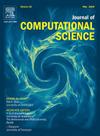孤立、球形对称、多成分燃料液滴蒸发和燃烧建模数值框架
IF 3.1
3区 计算机科学
Q2 COMPUTER SCIENCE, INTERDISCIPLINARY APPLICATIONS
引用次数: 0
摘要
本文提出了一个全面的数值框架,用于模拟孤立、球形对称、多组分燃料液滴的蒸发和燃烧。该框架对气相中的化学反应进行了详细描述,能够模拟纯蒸发、自燃和热线点火情景。液相中的扩散采用斯特凡-麦克斯韦理论进行描述,而气相中则考虑了分子扩散和热扩散。该模型还包括碳质颗粒的热传导效应,并通过各种模型(从光学稀薄近似法到 P1 和离散序数法等更复杂的方法)考虑气体辐射。非灰色辐射效应采用灰色气体加权总和模型(WSGGM)处理。液体/气体界面条件是通过施加质量和能量的通量连续性以及物种的热力学平衡来评估的。液滴中理想热力学行为的偏差可通过加入适当的活性系数或使用适当的立方状态方程来控制。此外,还使用简化的一维方法对支撑纤维的存在进行建模。输运方程采用线性法求解,空间离散化采用有限差分法在贴合人体的网格上进行。由于其在动力学和热力学描述方面的通用性以及计算时间的缩短,所提出的框架为我们提供了巨大的潜力,有助于加深我们对多组分液体燃料复杂燃烧过程的理解,并加强涉及孤立燃料液滴的实验的规划和执行。本文章由计算机程序翻译,如有差异,请以英文原文为准。
A numerical framework for modeling evaporation and combustion of isolated, spherically-symmetric, multi-component fuel droplets
This paper presents a comprehensive numerical framework for simulating the evaporation and combustion of isolated, spherically-symmetric, multi-component fuel droplets. The framework incorporates a detailed description of chemical reactions in the gaseous phase and is capable of modeling pure evaporation, autoignition, and hot-wire ignition scenarios.
The transport equations for mass, species, and energy are solved in both the liquid (droplet) and gaseous (surrounding atmosphere) phases. Diffusion in the liquid phase is described using the Stefan–Maxwell theory, while in the gaseous phase, both molecular and thermal diffusion are considered. The model also includes the thermophoretic effect for carbonaceous particles and accounts for gas radiation through various models, ranging from optically-thin approximations to more complex methods like the P1 and discrete ordinate methods. Non-gray radiative effects are handled using the Weighted-Sum-of-Gray-Gases Model (WSGGM). Liquid/gas interface conditions are evaluated by imposing flux continuity of mass and energy, along with thermodynamic equilibrium for species. Deviations from ideal thermodynamic behavior in the liquid droplet are managed by incorporating a suitable activity coefficient or by using a proper cubic equation of state. Additionally, the presence of supporting fibers is modeled using a simplified one-dimensional approach. The transport equations are solved using the method of lines, with spatial discretization performed via the finite difference method on a body-fitted grid. The resulting system of Differential–Algebraic Equations (DAEs) is then solved using a fully-coupled approach.
Thanks to its generality in terms of kinetic and thermodynamic descriptions and the reduced computational time, the proposed framework offers significant potential for advancing our understanding of the complex combustion processes of multi-component liquid fuels and for enhancing the planning and execution of experiments involving isolated fuel droplets.
求助全文
通过发布文献求助,成功后即可免费获取论文全文。
去求助
来源期刊

Journal of Computational Science
COMPUTER SCIENCE, INTERDISCIPLINARY APPLICATIONS-COMPUTER SCIENCE, THEORY & METHODS
CiteScore
5.50
自引率
3.00%
发文量
227
审稿时长
41 days
期刊介绍:
Computational Science is a rapidly growing multi- and interdisciplinary field that uses advanced computing and data analysis to understand and solve complex problems. It has reached a level of predictive capability that now firmly complements the traditional pillars of experimentation and theory.
The recent advances in experimental techniques such as detectors, on-line sensor networks and high-resolution imaging techniques, have opened up new windows into physical and biological processes at many levels of detail. The resulting data explosion allows for detailed data driven modeling and simulation.
This new discipline in science combines computational thinking, modern computational methods, devices and collateral technologies to address problems far beyond the scope of traditional numerical methods.
Computational science typically unifies three distinct elements:
• Modeling, Algorithms and Simulations (e.g. numerical and non-numerical, discrete and continuous);
• Software developed to solve science (e.g., biological, physical, and social), engineering, medicine, and humanities problems;
• Computer and information science that develops and optimizes the advanced system hardware, software, networking, and data management components (e.g. problem solving environments).
 求助内容:
求助内容: 应助结果提醒方式:
应助结果提醒方式:


